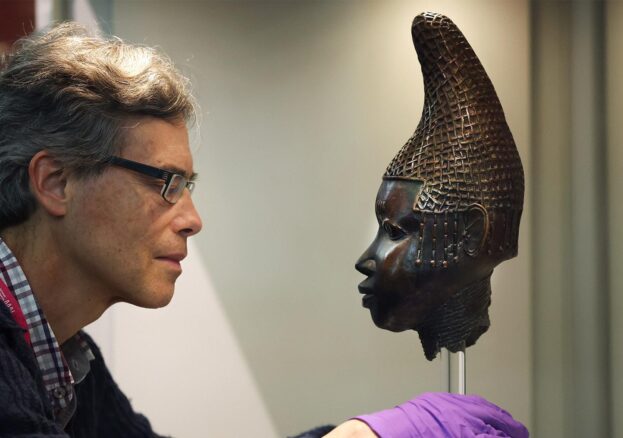
A new display at World Museum, Benin and Liverpool, opening on 18 March 2022, has been developed in collaboration with five Liverpool residents of African descent, to bring absent voices and new narratives to the presentation of the museum’s collections from Benin City in southern Nigeria.
Part of the #WMWhereNext campaign, Benin and Liverpool contributes to the ongoing discussions about World Museum’s colonial collections and the contexts in which they were acquired. The display shows the many connections, past and present, between Benin and Liverpool, including the part played by Liverpool’s commercial interests in southern Nigeria in the late nineteenth century. Most powerfully, it explores racism through the memories and experiences of the collaborators, evoked by their interaction and response to the objects and the history of Benin and the Edo Kingdom.
In a move towards a more equal partnership between the museum and its audiences and communities, we invited five Liverpool residents of African descent to discuss their concerns about the museum’s previous Benin exhibit and their expectations for this project. The artist Leo Asemota worked with the group and helped identify key themes. The new display has been developed to bring absent voices and narratives to the presentation of World Museum’s collections from Benin City and to contribute to ongoing discussions about colonial collections in museums.
As well as displaying twenty-one original Benin artworks, including an elaborately carved elephant tusk damaged during the British devastation of Benin City in 1897, the display includes multi-screen audio visuals that bring contemporary Edo voices to the gallery and two contemporary artworks by internationally exhibited artist Leo Asemota:
Agents of the Union, 2008 (Leo Asemota). The charred diamond-shaped frames of these three prints connect the destruction of Benin City during the British conquest of the Edo Kingdom in February 1897 with Queen Victoria’s Diamond Jubilee celebrations. The Jubilee celebrations, which marked a peak of British imperial power, were held in June of the same year.
RECALL: The longMarch of Displacement, 2008 (Leo Asemota). This video captures a live artwork performed on 25 September 2008 on the Victoria Embankment from Westminster Bridge to the Queen Victoria Diamond Jubilee memorial inscription at St Paul’s Cathedral. The performance plays with and connects the commemorative practices of Benin City and London across cultural boundaries.
The creation of Benin and Liverpool involved the committed contributions of Nasra Elliott, Saffron Francis, Otis Graham, Ashleigh Nugent, and Emy Onuora.
Speaking with Black History 365 Nasra Elliott said: “Being both a scouser, a member of the African diaspora, and a lover of African history and culture I saw this as a great opportunity. I see my position as a member of the diaspora as unique, having a foot in both camps. I wanted to be involved in the debate on restitution to hopefully speak on behalf of the voices that are often stonewalled from the dialogue and to build on my personal knowledge of West African Civilizations.
I think the display is more inviting to the audience, it encompasses colours more fitting to the Benin kingdom and it explains the history of the punitive expedition more explicitly which is needed for context.
Otis Graham added: “By restoring humanity to a nation, humanity as a whole is restored.”
Janet Dugdale, Executive Director of Museums & Participation, National Museums Liverpool said: “Across National Museums Liverpool, we are thinking about new ways to use objects to understand our collective past, present and future. In Benin and Liverpool, we proactively confront questions about Britain’s colonial history, its legacies and our collections.
This collaborative and inclusive process was challenging, creative and rewarding. We hope it tells a more human story that confronts historical injustices and connects Benin and Liverpool within a global context. ”
From the latest research into our collections, World Museum has 51 Benin artworks in various materials (copper alloy, ivory, stone, wood) that are highly likely to have been acquired directly or indirectly from participants in the British looting of Benin City in 1897. This figure does not include one item that was destroyed in the fire at the Museum in 1941.
The new display is the second in a series of interventions across the Museum’s World Cultures Gallery, following on from I, too, am a Survivor, intended to contribute to ongoing discussions about the future of colonial collections as part of its #WMWhereNext campaign.
www.liverpoolmuseums.org.uk/worldcultures #WMWhereNext
